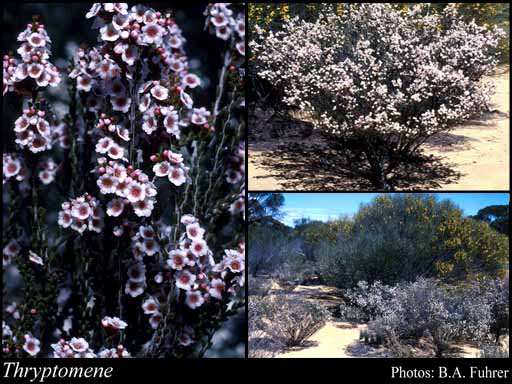- Reference
- Stirp.Herb.Huegel. p192 (1838)
- Name Status
- Current







Scientific Description
Common name. Thryptomenes. Family Myrtaceae.
Habit and leaf form. Shrubs, or ‘arborescent’ (rarely); evergreen; bearing essential oils. Plants with neither basal nor terminal concentrations of leaves; to 0.5–2.5 m high. Leptocaul. Helophytic to xerophytic. Leaves minute to small; opposite; decussate; decurrent on the stems, or not decurrent on the stems; ‘herbaceous’, or leathery; subsessile to sessile; gland-dotted; aromatic; edgewise to the stem, or with ‘normal’ orientation; simple; epulvinate. Leaf blades dorsiventral, or isobilateral, or centric; entire; flat; linear, or lanceolate, or oblong, or ovate; linear, or obovate, or elliptic, or orbicular; pinnately veined, or parallel-veined, or one-veined; cross-venulate, or without cross-venules. Mature leaf blades adaxially glabrous; abaxially glabrous. Leaves without stipules; without a persistent basal meristem. Leaf anatomy. Hairs absent. Stem anatomy. Secondary thickening developing from a conventional cambial ring.
Reproductive type, pollination. Fertile flowers hermaphrodite. Unisexual flowers absent. Plants hermaphrodite. Entomophilous, or ornithophilous. Pollination mechanism conspicuously specialized, or unspecialized.
Inflorescence and flower features. Flowers solitary (apparently), or aggregated in ‘inflorescences’; axillary. Inflorescences axillary; mostly solitary, or occasionally up to 3-flowered, with a very short to long peduncle. Flowers subsessile to sessile; (bi) bracteolate. Bracteoles persistent, or deciduous. Flowers minute to small; regular, or somewhat irregular; zygomorphic. The floral asymmetry (when noticeable) involving the perianth, or involving the androecium. Flowers 5(–6) merous; cyclic. Free hypanthium present (petals ‘inserted on the calyx’); turbinate, or tubular, or globose; adnate to the ovary, smooth, ribbed or rugose, rarely laterally flattened. Perianth with distinct calyx and corolla; 10, or 12; 2 -whorled; isomerous. Calyx present; 5(–6); 1 -whorled; polysepalous; spreading; imbricate, or valvate; green, or white, or cream. Sepals elliptic, or ovate, or triangular, or orbicular. Corolla present; 5(–6); 1 -whorled; polypetalous; imbricate; regular; plain, or with contrasting markings; white, or pink, or white and pink. Petals elliptic, or ovate, or orbicular; clawed, or sessile. Androecial members definite in number, or indefinite in number. Androecium 5–10, or 15–30. Androecial members branched, or unbranched. Androecial sequence determinable, or not determinable. Androecial members free of the perianth; all equal; free of one another; 1 -whorled. Androecium exclusively of fertile stamens, or including staminodes (occasionally in T. maisonneuvei, where the antepetalous whorl is reduced to sterile filaments). Staminodes 5. Stamens 5–10, or 15–30; attached on the rim of the hypanthium; remaining included (shorter than the petals); all more or less similar in shape; isomerous with the perianth to polystemonous; oppositisepalous, or alternisepalous and oppositisepalous (in a single whorl, although not always regularly opposite the perianth parts); both opposite and alternating with the corolla members, or all alternating with the corolla members; erect in bud, or inflexed in bud. Filaments not geniculate; filiform. Anthers dorsifixed; versatile; dehiscing via longitudinal slits; introrse; bilocular; tetrasporangiate; appendaged (with a prominent connective gland). Gynoecium 2 carpelled. The pistil 1 celled. Gynoecium syncarpous; eu-syncarpous; inferior. Ovary unilocular; 1 locular. Epigynous disk present. Gynoecium stylate. Styles 1; simple; apical. Stigmas 1. Placentation basal (to lateral). Ovules in the single cavity 2, or 4–8; horizontal to ascending; collateral, or superposed; non-arillate; anatropous.
Fruit and seed features. Fruit non-fleshy; indehiscent; a nut; 1 celled; 1(–2) seeded. Seeds non-endospermic; ellipsoidal-reniform. Cotyledons 2. Embryo curved.
Geography, cytology, number of species. Native of Australia. Endemic to Australia. Australian states and territories: Western Australia, South Australia, Northern Territory, Queensland, New South Wales, Victoria, Australian Capital Territory, and Tasmania. Eremaean Botanical Province and South-West Botanical Province.
Etymology. From the Greek for "broken or made small"; probably refers to the small flowers.
Keys
A Key to Western Australian Species in the Chamelaucieae Tribe of Myrtaceae
B.L. Rye, M.D. Barrett, T.D. Macfarlane, N.S. Lander, M.E. Trudgen, N.G. Marchant, K.R. Thiele
Taxonomic Literature
- Wheeler, Judy; Marchant, Neville; Lewington, Margaret; Graham, Lorraine 2002. Flora of the south west, Bunbury, Augusta, Denmark. Volume 2, dicotyledons. Australian Biological Resources Study.. Canberra..
- Rye, B. L.; Trudgen, M. E. 2001. A taxonomic revision of Thryptomene section Thryptomene (Myrtaceae).
- Blackall, William E.; Grieve, Brian J. 1980. How to know Western Australian wildflowers : a key to the flora of the extratropical regions of Western Australia. Part IIIA. University of W.A. Press.. [Perth]..
- Green, J. W. 1980. Thryptomene and Micromyrtus (Myrtaceae) in arid and semi-arid Australia.